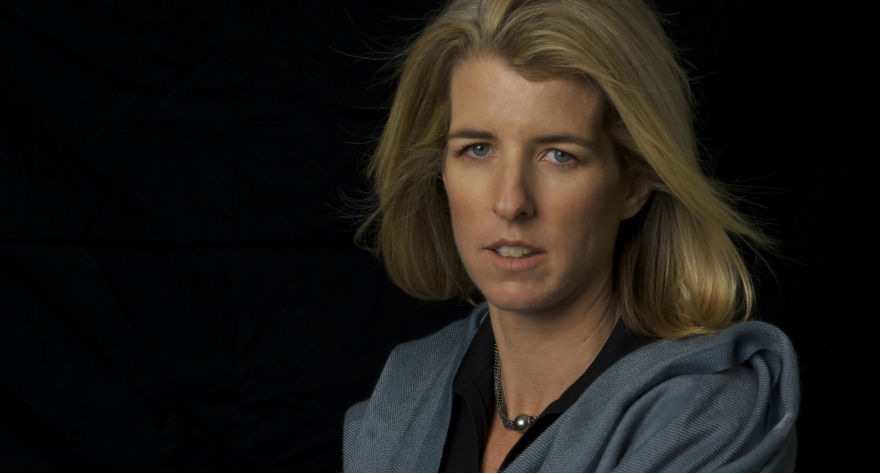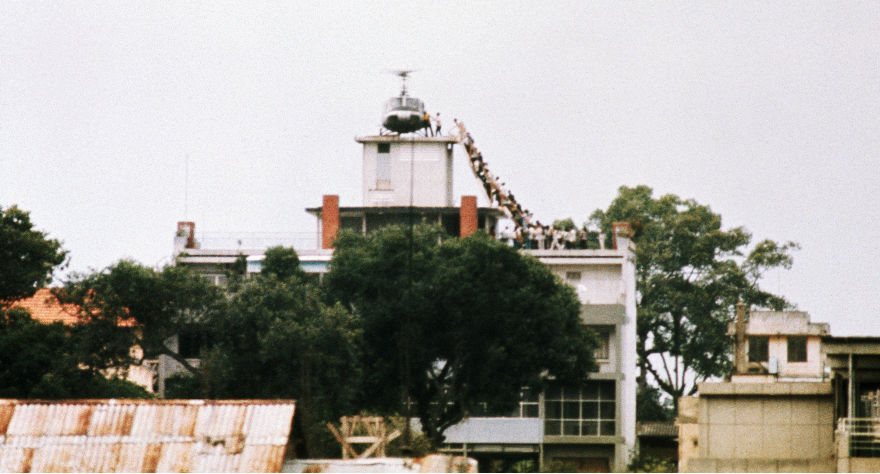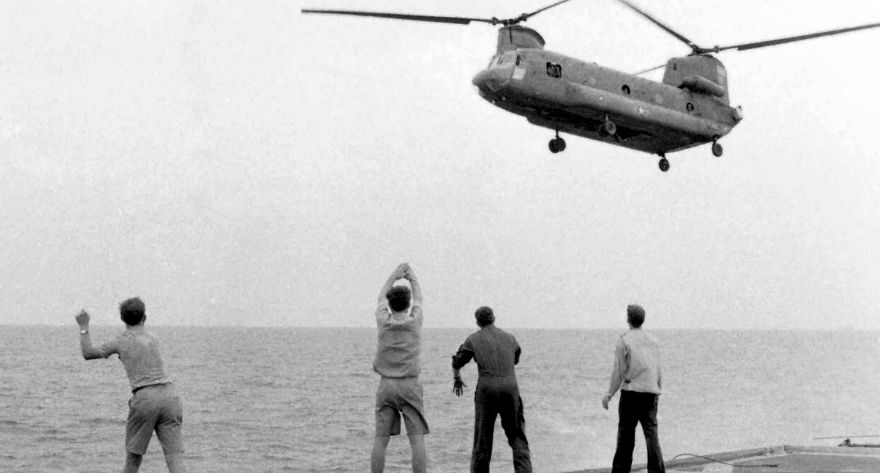Rory Kennedy on ‘Last Days in Vietnam’: Not Necessarily Proud of America, But Proud of These Americans

I remember writing essays about Robert F. Kennedy when I was a kid and studying his life for school. It’s the first research assignment I can remember having, and I must have been fascinated by it because I don’t remember much from my childhood. Fast forward about two decades, and there I am, astonished to be sitting across from the youngest of the late Kennedy’s eleven children, Rory Kennedy, whose new film, Last Days in Vietnam, covers a war her father felt should have been ended much sooner. I listened intently.
“He really felt we should get out of Vietnam,” the 45-year-old documentarian said of her father. “Some of my earliest memories seem to involve Vietnam in one capacity or another.” Inspired by her early fascination with Vietnam, she made Last Days, which recounts the final 24 hours of the war, when the North Vietnamese army was closing in on Saigon and U.S. troops were ordered to evacuate only U.S. citizens. Several American soldiers chose to disobey orders, however, risking their lives to help sneak South Vietnamese citizens and their families who were helpful to the U.S. military out of the country to safety. Through interviews with these intrepid men and some South Vietnamese citizens who were left behind, the film highlights an inspiring, encouraging moment in one of the country’s most regretful points in history.
I spoke with Kennedy during her visit to San Francisco about how she found the stories of these soldiers, her biggest challenges in making the film feel cohesive, having screaming matches in the editing room, the stories’ morally complex nature, finding the film’s rare archival footage, how we can learn to not repeat the same mistakes in our engagement with ISIS, advice for young filmmakers, and more.

The war in Vietnam has been covered in documentaries from so many different ways, but you’ve managed to find a new angle to approach the subject. How did you find this story?
I’ve always been fascinated by Vietnam and from a very young age have been aware of it. My father, Robert F. Kennedy, ran his last campaign in 1968 really because he felt we should get out of Vietnam. Some of my earliest memories seem to involve Vietnam in one capacity or another. As we were getting out of Iraq and Afghanistan, I thought that maybe it might be a good time to look back at the final days of Vietnam and see if there might be some lessons to be learned about what happened during those last days and what’s happening now. I also felt that we were coming up on the 40th anniversary of the fall of Saigon, so I thought it was a good time to look back.
The story of these brave men is so intrinsically dramatic. It makes for great movie material.
It’s an organically dramatic story, which was also appealing to me. When we’re making these documentaries, so much of the time you have to construct the story, figure out what it is, construct the arc of the story. [laughs] This one was kind of laid out for us on a platter. It was pretty evident in the first few days of research that there was a film there. Then it was a question of what angle to take and where the focus of the film should be. It was very evident that there was a dramatic story to be told that did have relevance.
Almost every documentarian I’ve spoken to tells me that their biggest challenge was finding their story and figuring out, like you said, what the arc of it should be. You had a bit of a leg up here, with the story already being so dramatic and cinematic. You were ahead of the game in that respect, so where did you focus the extra time and energy?
I was searching for the characters to help tell that story. That was a challenge, though we ended up finding a lot of fantastic people who told firsthand accounts. The archive, tracking down the visual elements of the story, was also quite a challenge. I wanted to try to minimize any reenactments or animations in this film. Not that I’m against those things…
The animations you do have are great.
When we use them, which is sparingly, I think the do what they need to do. I think that overall, you’re in the footage of the moment, so it helps transport audiences to April 1975 in Saigon and hopefully helps them have the experience of a ticking clock and what’s going to happen next in the moment, with the characters. I would say one of the bigger challenges of this film was the edit. Even though the story was pretty obvious, the this story, which a complex one involving situating people in Vietnam and giving them a sense of what they needed to know about Vietnam. We also had to make it relevant because you’re dealing with younger generations who may have not studied Vietnam and older generations who might know a lot of the backstory. We also never use a narrator or historians or so-called “experts”. It’s exclusively told through people who were there and had firsthand knowledge. They become your narrators, and we didn’t want to interrupt the flow of events by using cards. That’s just challenging. It just is. [laughs] You’re jumping from the water to the embassy to the airport. Then, you have to situate people and orient them.
There’s so much information delivered in the movie that it’s like tap-dancing over laser beams; one misstep and the audience might shut off.
And then you have to figure out what that misstep is. You watch it in rough cut stage. I was in the edit room with my writers Mark Bailey and Keven McAlester, who are both terrific, and my editor Don Kleszy. It was a great collaboration, and we all had a lot of contributions to all of those decisions you make. Lots of yelling and screaming matches as to what happens next and how you structure it. It was great to have such a team together.
The stories of these men are so morally complex. They were presented with situations in which the right thing to do isn’t always so clear. I couldn’t help but put myself in their shoes and wonder what I would have done under such duress, and how I would reckon with decisions I wasn’t so sure were the right ones.. Did you ever try to put yourself inside their place and go to that dark place?
It’s so hard for me to imagine being in their position exactly. I’d have to know how to drive a helicopter, you know? [laughs] There are so many experiences I would have to have to get to where they were. But of course, the moral dilemma they faced I can identify with more. We all like to hope that we’d make the right decision, but it’s difficult when you’re in the military and taught not to make decisions on your own. One of the things that’s amazing is that there are all these disparate stories that are all taking place around or in Saigon, and none of them were talking to each other. But they all came to the same conclusion, which is, “We can’t just leave. We have to help these guys.” That’s an amazing phenomenon, really. I think the war in Vietnam was a dark moment in our nation’s history that not many Americans are proud of, but you see these acts of these individuals and how they sacrificed their jobs and arguably their lives, and were going against U.S. policy. And yet, they still did it. It makes you proud of them. Not necessarily proud of America, but proud of these Americans.
Have audiences been coming away from the film encouraged by these stories?
Yeah, that’s certainly an emotion people feel when they leave the film. Listen, it’s all within the context of a larger abandonment, right? I don’t think the film skirts around that larger issue. I don’t know that audiences are skipping out of the theater all bliss-ed out. [laughs] But people have certainly expressed a feeling of pride in these individuals.
I think this film can help us and our government not repeat the same mistakes we made back then.
That would be nice! [laughs] When I went into it, I didn’t have that particular goal in mind. I wanted to tell this story, and I felt that there were lessons to be learned; what we did in Vietnam, what worked and didn’t work, the larger questions about our responsibilities to people left behind. What happens to the messengers and the tailors and the cooks and the translators and all the people who work with us when we leave Afghanistan. What happens to them? They face greater vulnerability because of their association with Americans. I think it’s important to ask those questions and have a sense of the answers as we expand our engagements to ISIS. What is our goal? What is the cost of war? What happens to the people who get left behind? In April 1975, there were very few good options available. It’s a reminder that we should be asking these questions before we get into the wars. At a certain point, especially if you don’t win, you’re limited in your options.

What are the rarest pieces of footage you have in the film?
We were really lucky, because I had a great archive team who went into the NBC and ABC and CBS archive houses and found the source material. Throughout the film there is footage people have never seen before. We were particularly lucky with the story about the U.S.S. Kirk, which plays a significant role in the movie, where I was telling a guy who had helped uncover the story of the Kirk about the film, and he had just talked to a sailor from the Kirk who had told him that he was up in his attic and came across a box of Super 8 undeveloped footage of the Kirk in 1975. I was in California and he was on the East Coast and wouldn’t FedEx it to me, so I flew him out and we developed it, and it was a treasure trove. The U.S.S. Kirk, the Armitage story, the sequence with the ships overflowing with people; that’s all from this footage.
There’s a remarkable moment in the film where as a man is saying, “You wouldn’t believe me if I told you, but we were pushing helicopters over the side of the boat,” we see actual footage of them pushing helicopters off the boat. It’s amazing.
[laughs] Yeah, it’s an amazing moment.
As is the case for every documentary project, the work is only halfway done once the film is finished. How have you enjoyed your time since completing the film, screening it for audiences, doing interviews like this and appearing on TV shows?
I love it. It takes a certain amount of energy, and you’ve got to really love the story. It requires working on all cylinders. I am enormously grateful to be on this path. I learn something new almost every day that I’m doing this work. I really love and honor it, and I think it’s a great group of people who make documentaries, and I love the association with that group. I love what I do. It’s such a spectrum of experiences making a film, and what I love is that in that range, I enjoy almost every part of it. I enjoy developing an idea; I enjoy doing interviews and identifying the characters; I enjoy the edit, which is always very, very challenging. I’m always convinced at some point that this is a terrible project and I should have never done it and no one’s going to watch it because it’s horrible. It’s a roller coaster, and that’s the low point, but it has always so far gone to a high point. It’s great to be able to share the movie and see audiences’ responses to it. I enjoy talking to people like yourself who have enjoyed the film and who are smart and engaged and care about it and have different ways of looking at it.
I think every creative person–whether they’re creating a film, a book, a song, whatever–hits that low point you were talking about, where the project is so, so far from what you want it to be that you want to give up. For me, after I hit rock bottom like that, there’s always a point that follows where something clicks and you get hopeful. Can you remember what that point was?
I remember that point for my previous film, Ethel. We nailed the open of the film, and that set the tone for the rest of it, which was hard to figure out before that point. This film was more of a slog in terms of building it all so that the entire film worked. We could build certain scenes, and I could see how those worked, but it was still hard to make it feel like the overall story would hold together. There were so many stories and no narration. I always talk about this metaphor, where you bake bread and put it in the oven and hope it rises, but sometimes it doesn’t. Sometimes, you watch the film and you’re like, “Gah! It’s terrible!” or you watch it and you’re like, “Oh! It works!” For this film, it was like every little thing had to be put together, and then it finally worked. But it wasn’t until the very end where it felt like it was really a film.
We finished a second, maybe third rough cut of the film in May, and then we took the summer off, which I’ve never done before. Everybody was like, “The film’s solid! We maybe just need to make a few tweaks when we get back.” We came back in September and watched it and were like, “Okay. We need to redo this.” We had six weeks, and we made a lot of pretty radical changes to it, and it turned it from an okay film to a much, much better film. For all of us to have that distance and reengage it was great.
Any advice for young documentary filmmakers?
It’s a life of endeavor. When I was starting making documentaries, it cost $80,000 to have a camera that was broadcast quality and editing systems were $200,000 to $300,000. We had to edit linearly…
Imagine that for this film!
[laughs] I know! There’s so much opportunity now, where you can pick up a phone now and make a film out of it, and it’s arguably broadcast quality. It really opens up the field to a lot of young people who may not have the resources, but have the wherewithal and ingenuity to pursue their calling. There’s also value to working with a production company or with people whose work you admire. Do internships and assistant work to figure out how the overall industry works. That’s important in terms of being practical about how you make a film. If you can just go out there and start making them, that’s a fantastic experience.
